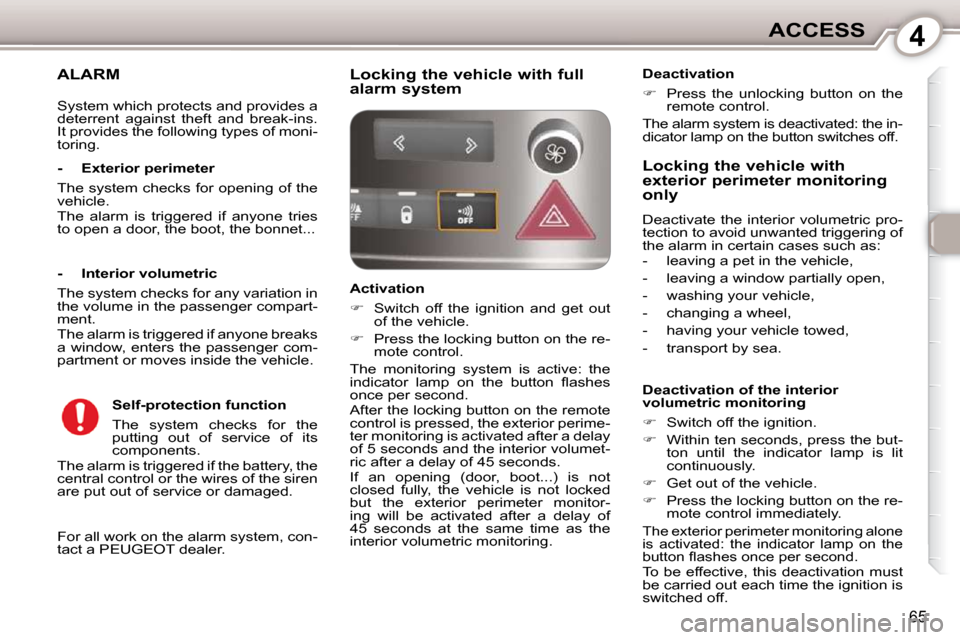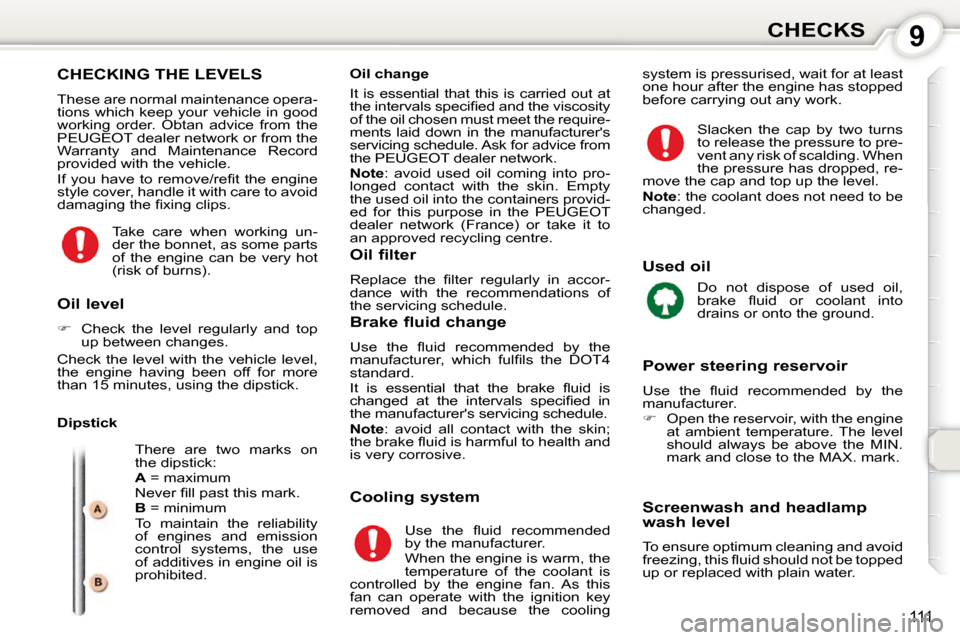2010 Peugeot 407 Dag open bonnet
[x] Cancel search: open bonnetPage 2 of 249

FAMILIARISATION
Remote control key
A. Unfolding/folding the key.
B. Unlocking the vehicle
(brief press).
C. Unlocking and partial opening of the
boot (saloon) or of the rear screen
(SW)
(long press).
Also...
D. Normal locking
(a single press)
or
deadlocking of the vehicle
(two presses in succession).
Fuel tank
1. � � �O�p�e�n�i�n�g� �t�h�e� �f�u�e�l� �fi� �l�l�e�r� �fl� �a�p�.�
2. � � �O�p�e�n�i�n�g� �a�n�d� �h�o�o�k�i�n�g� �t�h�e� �f�u�e�l� �fi� �l�l�e�r�
cap.
Tank capacity: approximately 67 litres.
A. Interior release lever
B. Exterior safety catch.
� 61
� 72 � 106
Bonnet
Page 72 of 249

4ACCESS
65
ALARM
For all work on the alarm system, con-
tact a PEUGEOT dealer.
- Exterior perimeter
The system checks for opening of the
vehicle.
The alarm is triggered if anyone tries
to open a door, the boot, the bonnet...
- Interior volumetric
The system checks for any variation in
the volume in the passenger compart-
ment.
The alarm is triggered if anyone breaks
a window, enters the passenger com-
partment or moves inside the vehicle.
Self-protection function
The system checks for the
putting out of service of its
components.
The alarm is triggered if the battery, the
central control or the wires of the siren
are put out of service or damaged. Locking the vehicle with full
alarm system
Activation
� Switch off the ignition and get out
of the vehicle.
� Press the locking button on the re-
mote control.
The monitoring system is active: the
�i�n�d�i�c�a�t�o�r� �l�a�m�p� �o�n� �t�h�e� �b�u�t�t�o�n� �fl� �a�s�h�e�s�
once per second.
After the locking button on the remote
control is pressed, the exterior perime-
ter monitoring is activated after a delay
of 5 seconds and the interior volumet-
ric after a delay of 45 seconds.
If an opening (door, boot...) is not
closed fully, the vehicle is not locked
but the exterior perimeter monitor-
ing will be activated after a delay of
45 seconds at the same time as the
interior volumetric monitoring.
System which protects and provides a
deterrent against theft and break-ins.
It provides the following types of moni-
toring.
Deactivation
� Press the unlocking button on the
remote control.
The alarm system is deactivated: the in-
dicator lamp on the button switches off.
Locking the vehicle with
exterior perimeter monitoring
only
Deactivate the interior volumetric pro-
tection to avoid unwanted triggering of
the alarm in certain cases such as:
- leaving a pet in the vehicle,
- leaving a window partially open,
- washing your vehicle,
- changing a wheel,
- having your vehicle towed,
- transport by sea.
Deactivation of the interior
volumetric monitoring
� Switch off the ignition.
� Within ten seconds, press the but-
ton until the indicator lamp is lit
continuously.
� Get out of the vehicle.
� Press the locking button on the re-
mote control immediately.
The exterior perimeter monitoring alone
is activated: the indicator lamp on the
�b�u�t�t�o�n� �fl� �a�s�h�e�s� �o�n�c�e� �p�e�r� �s�e�c�o�n�d�.�
To be effective, this deactivation must
be carried out each time the ignition is
switched off.
Page 121 of 249

9CHECKS
106
Bonnet stay BONNET
Handle the exterior safety catch and
the bonnet stay with care when the en-
gine is hot (risk of burns).
Opening
From inside: pull the release lever on
the left-hand side under the dashboard
towards you.
From outside: move the safety catch to
the left and up then raise the bonnet. Secure the stay in its housing to hold
the bonnet open.
Before closing the bonnet, replace the
stay in its clip. Closing
Lower the bonnet and release it at the
end of its travel. Check that the bonnet
is fully closed.
Page 126 of 249

9CHECKS
111
CHECKING THE LEVELS
These are normal maintenance opera-
tions which keep your vehicle in good
working order. Obtan advice from the
PEUGEOT dealer network or from the
Warranty and Maintenance Record
provided with the vehicle.
� �I�f� �y�o�u� �h�a�v�e� �t�o� �r�e�m�o�v�e�/�r�e�fi� �t� �t�h�e� �e�n�g�i�n�e�
style cover, handle it with care to avoid
�d�a�m�a�g�i�n�g� �t�h�e� �fi� �x�i�n�g� �c�l�i�p�s�.�
Dipstick There are two marks on
the dipstick:
A = maximum
� �N�e�v�e�r� �fi� �l�l� �p�a�s�t� �t�h�i�s� �m�a�r�k�.�
B = minimum
To maintain the reliability
of engines and emission
control systems, the use
of additives in engine oil is
prohibited.
Oil level
� Check the level regularly and top
up between changes.
Check the level with the vehicle level,
the engine having been off for more
than 15 minutes, using the dipstick. Oil change
It is essential that this is carried out at
�t�h�e� �i�n�t�e�r�v�a�l�s� �s�p�e�c�i�fi� �e�d� �a�n�d� �t�h�e� �v�i�s�c�o�s�i�t�y�
of the oil chosen must meet the require-
ments laid down in the manufacturer's
servicing schedule. Ask for advice from
the PEUGEOT dealer network.
Note : avoid used oil coming into pro-
longed contact with the skin. Empty
the used oil into the containers provid-
ed for this purpose in the PEUGEOT
dealer network (France) or take it to
an approved recycling centre. system is pressurised, wait for at least
one hour after the engine has stopped
before carrying out any work.
Oil filter
� �R�e�p�l�a�c�e� �t�h�e� �fi� �l�t�e�r� �r�e�g�u�l�a�r�l�y� �i�n� �a�c�c�o�r�-
dance with the recommendations of
the servicing schedule.
Brake fluid change
� �U�s�e� �t�h�e� �fl� �u�i�d� �r�e�c�o�m�m�e�n�d�e�d� �b�y� �t�h�e�
�m�a�n�u�f�a�c�t�u�r�e�r�,� �w�h�i�c�h� �f�u�l�fi� �l�s� �t�h�e� �D�O�T�4�
standard.
� �I�t� �i�s� �e�s�s�e�n�t�i�a�l� �t�h�a�t� �t�h�e� �b�r�a�k�e� �fl� �u�i�d� �i�s�
�c�h�a�n�g�e�d� �a�t� �t�h�e� �i�n�t�e�r�v�a�l�s� �s�p�e�c�i�fi� �e�d� �i�n�
the manufacturer's servicing schedule.
Note : avoid all contact with the skin;
�t�h�e� �b�r�a�k�e� �fl� �u�i�d� �i�s� �h�a�r�m�f�u�l� �t�o� �h�e�a�l�t�h� �a�n�d�
is very corrosive. Used oil
Power steering reservoir
� �U�s�e� �t�h�e� �fl� �u�i�d� �r�e�c�o�m�m�e�n�d�e�d� �b�y� �t�h�e�
manufacturer.
� Open the reservoir, with the engine
at ambient temperature. The level
should always be above the MIN.
mark and close to the MAX. mark.
Cooling system Screenwash and headlamp
wash level
To ensure optimum cleaning and avoid
�f�r�e�e�z�i�n�g�,� �t�h�i�s� �fl� �u�i�d� �s�h�o�u�l�d� �n�o�t� �b�e� �t�o�p�p�e�d�
up or replaced with plain water. Slacken the cap by two turns
to release the pressure to pre-
vent any risk of scalding. When
the pressure has dropped, re-
move the cap and top up the level.
Note : the coolant does not need to be
changed.
� �U�s�e� �t�h�e� �fl� �u�i�d� �r�e�c�o�m�m�e�n�d�e�d�
by the manufacturer.
When the engine is warm, the
temperature of the coolant is
controlled by the engine fan. As this
fan can operate with the ignition key
removed and because the cooling Do not dispose of used oil,
�b�r�a�k�e� �fl� �u�i�d� �o�r� �c�o�o�l�a�n�t� �i�n�t�o�
drains or onto the ground.
Take care when working un-
der the bonnet, as some parts
of the engine can be very hot
(risk of burns).